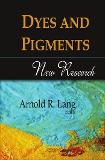| dc.description.abstract | Dyes and pigments are substances that impart colour to a material. The term colorant is often used for both dyes (also called dyestuffs) and pigments. The major difference between dyes and pigments is solubility (the tendency to dissolve in a liquid, especially water). Dyes are usually soluble - or can be made to be soluble - in water. Once a dye is dissolved in water, the material to be dyed can be immersed in the dye solution. As the material soaks up the dye and dries, it develops a colour. If the material then retains that colour after being washed, the dye is said to be colourfast.Pigments are generally not soluble in water, oil, or other common solvents. To be applied to a material, they are first ground into a fine powder and thoroughly mixed with some liquid, called the dispersing agent or vehicle. The pigment-dispersing agent mixture is then spread on the material to be coloured. As the dispersing agent dries out, the pigment is held in place on the material. In most cases, dyes are used for colouring textiles, paper, and other substances, while pigments are used for coloring paints, inks, cosmetics, and plastics. This book presents new and significant research from around the world in this field. | en_US |











